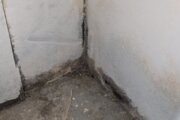Humpty Dumpty sat on a wall,
Humpty Dumpty had a great fall.
All the king’s horses and all the king’s men
Couldn’t put Humpty together again
As a certain English nursery rhyme suggests, walls are frequently tied to bad events.
Even so, history shows people in power continually return to the idea of building a wall. Dating back thousands of years, empires, kingdoms and nations have built walls. Most have been built to keep a perceived threat out, such as the Great Wall of China. Others were intended to keep people contained in a space, such as the Cold War-era Berlin Wall in what is today a unified Germany.
As the presidential debates between Democrat Hillary Clinton and Republican Donald Trump get underway, attention will re-focus on the GOP nominee’s immigration rhetoric and one of his campaign pillars: the promise to force Mexico to pay for building a wall along the country’s 2,000-mile land border with the United States.
Trump may be wise to consider the perspectives of historians and social scientists. Most say that regardless of what side of a wall voters fall on politically, they should know that the structures have generally been ineffective. People often find ways to bypass border barriers, analysts say, and often, walls bring about results opposite from what was intended.
“The concept of the wall is flawed. It’s simply impossible to limit contacts between people,” says Juan Santamarina, history professor at the University of Dayton.
That view hasn’t stopped countries from building barriers, including a fence that exists today along parts of the U.S.-Mexico border. Construction of that fence began in 2006 under the George W. Bush administration, but was partially suspended in 2010 by President Barack Obama.
Other notable present-day barriers include the five- to eight-meter high wall separating Israel from the West Bank; the demilitarized zone between South Korea and North Korea and the “Peace Walls” separating Catholic and Protestant communities in Northern Ireland.
In Kashmir, a region in northern India and southern Pakistan that both countries claim, a Line of Control runs along the border separating Indian- and Pakistani-controlled areas. The two countries have fought twice over Kashmir and also possess nuclear capabilities, leading many to call the Line of Control one of the most dangerous frontiers in the world.
In fact, the number of border barriers across the globe today is on the rise. Research by Canadian academic Élisabeth Vallet and illustrated by the Washington Post shows the construction of walls has jumped dramatically since the Sept. 11, 2001 terror attacks. Across Europe, anxieties caused by the Russian annexation of Crimea from Ukraine and a refugee crisis not seen since the end of World War II have triggered construction of new barriers. The continent is now on pace to have more physical barriers along countries’ borders than during the Cold War, according to work by Vallet and other researchers and reported by The Economist.
Walls are usually connected to some kind of conflict. It was during the Cold War that one of history’s most famous barriers — the Berlin Wall — was built to divide the U.S.-, British– and French-controlled districts of the city from the part controlled by the former Soviet Union. Aug. 13 th of this year marked the 55 th anniversary of construction of the wall, which began to open in November 1989 and was demolished the following year.
“The danger of a wall is it reduces that conflict to a technical structure,” says Paul Steege, a history professor at Villanova University who extensively studied the Berlin Wall. “The West was very comfortable with the Berlin Wall. It made it easier to avoid conflict.”
“Walls are tied up with fantasies about what they can do,” adds Steege, who says that daily interaction took place between people in East and West Berlin.
[ READ: The public’s responsibility to refugees]
Today in Hungary, where a far-right government is in power, work is stepping up to build a second razor wire fence on the border with Serbia in an effort to prevent refugees and other migrants from entering the country.
“I’m very skeptical of this working,” says Martin Kahanec, a professor at the School of Public Policy at Central European University in Budapest. Kahanec says the move by Hungary to send people who illegally enter the country back to the border is creating new humanitarian issues, as refugees spend weeks housed in poor living conditions, waiting to enter the country.
“It’s only in a crisis that people consider walls,” says Santamarina. “People have usually considered walls to be a bad thing. They are designed for keeping out what is different.”
Analysts say border barriers can pose new unforeseen problems. Noting labor shortages in Europe that are “across the spectrum,” Kahanec says Hungary’s move to uniformly bar all migrants from freely entering the country and wait to apply for permission may have economic consequences.
European governments need to agree on a system that manages the free flow of people, Kahanec says. “Migration and labor mobility is essential for a healthy economy. These kind of border measures (the Hungarian razor wire fence) do not help the country putting them up.”
Migration issues the West faces today also posed challenges for the Roman Empire nearly 2,000 years ago. In the year 122, Emperor Hadrian ordered construction of an east-to-west fortification in Britannia, stretching from the North Sea to the Irish Sea. Hadrian’s Wall “was a disaster,” says Steve Tuck, professor and Chair of Classics at Miami University. Hadrian’s Wall was ineffective as a self-defense measure, but it was a statement of power. That wall failed, Tuck says, because it abandoned Roman principles of “imperium sine fine” — empire without end — and a culture that embraced inclusive citizenship.
“It didn’t prevent people from entering the Empire. It ultimately led to the end of the Roman Empire.”
[ MORE: Austrian leader: EU’s outer borders must be better protected]
Building walls can come at great costs. That was the case with the Great Wall of China, a series of fortifications built beginning as early as the 7 th century BCE and intended to prevent invasion from northern tribes. Thousands of workers’ lives were lost building the wall, says Michael Noble, history faculty member at Eastfield College, in a written response to questions. Ultimately, the Great Wall failed its intended purpose as Mongols under the Khans swept across Asia and into Europe.
Central to the GOP nominee’s campaign is his promise to crack down on illegal immigration and to force Mexico to pay for a wall along the border. But any moves to rapidly deport millions of illegal immigrants and build a border wall would carry astronomical costs for what almost every objective analysis shows would ultimately be ineffective measures.
Building walls are often triggered by fear, real or imagined, by a group within a country. In the U.S., changing demographics and growing inequality have fueled the populist anger that has fed the Trump campaign, whose strongest support comes from white voters.
The U.S. is becoming more ethnically diverse. So much so that Pew estimates that by the middle of this century, the country will not have a single ethnic or racial majority. Trump may want to explore research by the nonpartisan organization, which shows his immigration rhetoric targeting Mexico is misplaced. While the overall number of unauthorized immigrants entering the U.S. has remained steady since 2009, the share from Mexico is dropping, according to Pew. Additionally, research from the organization shows more Mexican immigrants are leaving the U.S. than coming into the country.
“Diversification of the U.S. is seen as a threat to some people,” says Dayton’s Santamarina. “There is this feeling that ‘they’ look different. ‘They’ use another language.”
[ POLL: Young adults divided on immigration, border control]
Santamarina, who focuses on Latin American history, notes the old Spanish Empire built fortified outposts as it explored and conquered the indigenous peoples throughout the Americas, with bases stretching from St. Augustine, Florida, to Cuba and Puerto Rico. Today, Spain uses high fencing in North Africa to create a border around two enclave cities in Morocco, Ceuta and Melilla.
Perhaps the greatest problem with a wall is the reactive mindset behind it, says Miami University’s Tuck. “When you have a wall, you have to guess where they’re coming from. It will ultimately fail because it’s a reactive policy that you can’t keep up.
“It’s more effective to have good diplomacy than have a wall.”
More from U.S. News
What’s More Effective Than a Wall on the Border?
In Trump, the World Sees ‘The Ugly American’
Photos: Border Walls Through History
Donald Trump’s Plan For a Wall Has Many Cracks, Analysts Say originally appeared on usnews.com







